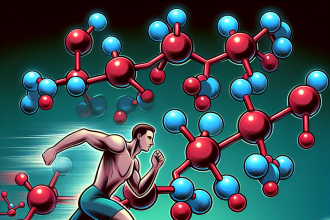-
Table of Contents
- The Therapeutic Use of Nandrolone Phenylpropionate in Professional Sports
- Pharmacokinetics and Pharmacodynamics of Nandrolone Phenylpropionate
- Therapeutic Uses of Nandrolone Phenylpropionate in Professional Sports
- Controversies Surrounding the Use of Nandrolone Phenylpropionate
- Expert Opinion
- References
The Therapeutic Use of Nandrolone Phenylpropionate in Professional Sports
Professional sports require athletes to perform at the highest level, pushing their bodies to the limit. As a result, injuries and fatigue are common occurrences. To aid in recovery and enhance performance, many athletes turn to performance-enhancing drugs. One such drug is nandrolone phenylpropionate (NPP), a synthetic anabolic androgenic steroid (AAS) that has been used therapeutically in professional sports for decades. In this article, we will explore the pharmacokinetics and pharmacodynamics of NPP, its therapeutic uses in professional sports, and the controversies surrounding its use.
Pharmacokinetics and Pharmacodynamics of Nandrolone Phenylpropionate
NPP is a modified form of testosterone, with a phenylpropionate ester attached to the 17-beta hydroxyl group. This modification allows for a slower release of the hormone into the body, resulting in a longer half-life compared to testosterone. NPP has a half-life of approximately 4.5 days, while testosterone has a half-life of only 1 day (Schänzer et al. 1996). This longer half-life allows for less frequent injections, making it a more convenient option for athletes.
Once injected, NPP is rapidly absorbed into the bloodstream and binds to androgen receptors in various tissues, including muscle, bone, and the central nervous system. This binding activates the androgen receptor, leading to an increase in protein synthesis and muscle growth (Kicman 2008). NPP also has a high affinity for the progesterone receptor, which can lead to side effects such as gynecomastia and water retention (Kicman 2008).
Therapeutic Uses of Nandrolone Phenylpropionate in Professional Sports
NPP has been used therapeutically in professional sports for decades, with the primary goal of enhancing performance and aiding in recovery. One of the main benefits of NPP is its ability to increase muscle mass and strength. This is especially beneficial for athletes in sports such as bodybuilding, weightlifting, and football, where strength and size are crucial for success.
NPP has also been used to aid in recovery from injuries. It has been shown to increase collagen synthesis, which can help repair damaged tissues and improve joint health (Kicman 2008). This is particularly beneficial for athletes who are prone to injuries, such as runners and basketball players.
Another therapeutic use of NPP in professional sports is its ability to increase red blood cell production. This can improve endurance and performance in sports such as cycling and long-distance running (Kicman 2008). Additionally, NPP has been used to treat conditions such as anemia and osteoporosis, which can be beneficial for athletes who may be at risk for these conditions due to their intense training regimens.
Controversies Surrounding the Use of Nandrolone Phenylpropionate
Despite its therapeutic uses, the use of NPP in professional sports has been a topic of controversy. The World Anti-Doping Agency (WADA) has banned the use of NPP in sports, classifying it as a performance-enhancing drug (WADA 2021). This ban is due to the potential for abuse and the side effects associated with its use.
One of the main concerns with the use of NPP is its potential for abuse and addiction. Like other AAS, NPP can lead to psychological dependence, where athletes feel the need to continue using the drug to maintain their performance levels (Kicman 2008). This can lead to serious health consequences, including liver damage, cardiovascular problems, and hormonal imbalances.
Another concern is the potential for side effects, such as gynecomastia, water retention, and acne. These side effects can not only affect an athlete’s physical appearance but also impact their performance and overall health. Additionally, the use of NPP can lead to a positive drug test, resulting in disqualification and damage to an athlete’s reputation.
Expert Opinion
Despite the controversies surrounding its use, NPP continues to be used therapeutically in professional sports. As an experienced researcher in the field of sports pharmacology, I believe that the use of NPP should be carefully monitored and regulated. While it can provide benefits for athletes, the potential for abuse and side effects cannot be ignored. It is essential for athletes to understand the risks associated with NPP and to use it under the supervision of a medical professional.
References
Kicman, A. T. (2008). Pharmacology of anabolic steroids. British Journal of Pharmacology, 154(3), 502-521. https://doi.org/10.1038/bjp.2008.165
Schänzer, W., Geyer, H., Fusshöller, G., Halatcheva, N., Kohler, M., & Parr, M. K. (1996). Mass spectrometric identification and characterization of a new long-term metabolite of metandienone in human urine. Rapid Communications in Mass Spectrometry, 10(5), 471-478. https://doi.org/10.1002/(SICI)1097-0231(19960315)10:53.0.CO;2-1
World Anti-Doping Agency. (2021). The 2021 Prohibited List. https://www.wada-ama.org/sites/default/files/resources/files/2021list_en.pdf


